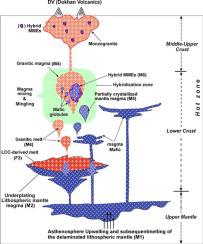Precambrian Research ( IF 3.2 ) Pub Date : 2021-09-20 , DOI: 10.1016/j.precamres.2021.106380 H.A. Eliwa 1 , R. Deevsalar 2 , N.M. Mahdy 3 , S. Kumar 4 , Kh. El-Gameel 1 , T. Zafar 5 , I.M. Khalaf 1 , M. Murata 6 , H. Ozawa 6 , A. Andresen 7 , D. Chew 8 , M.M. Fawzy 3 , A. Afandy 3 , Y. Kato 9 , K. Fujinaga 9

|
The Neoproterozoic Gharib Granitoid Complex (GGC), in the North Eastern Desert (NED) of Egypt, is characterized by the occurrence of varieties of granitoids. Monzogranite, the most abundant granite variety, contains abundant magmatic microgranular enclaves (MMEs) of mafic to intermediate composition. The MMEs are more mafic than their host and marked by a greater amount of amphibole and biotite. They are finer grained and have porphyritic/poikilitic textures.
The sharp, crenulated, and fine-grained quenched contacts of the elongated, rounded, and ellipsoid form of the MMEs with their felsic host indicate rapid cooling during a magma mixing/mingling event. Micro-textural evidence supports the mechanical transfer of minerals that crystallized in felsic magma to the mafic melt (e.g., feldspar phenocrysts cross-cutting the MME-host boundaries, stubby apatite, quartz ocelli, and poikilitic outermost rims of K-feldspar phenocrysts), supercooling/quenching process (e.g., acicular apatite and elongated hornblende and biotite crystals), and disequilibrium growth (e.g., hornblende-biotite clots replaced early crystallized clinopyroxene), which also favour a magma mingling/mixing origin. Linear to curvilinear chemical variations of the MMEs and the host monzogranites on Harker diagrams, highly similar trace element contents, and Sr-Nd isotopic systematics together with mineral-chemical features also support mixing/mingling as the main process in magma genesis and strongly suggest that the MMEs were supercooled hybrid globules within cooler, partially crystallized host felsic magma. The crust-like geochemical signatures (i.e., SiO2 content, metaluminous nature, and lack of upper crustal xenoliths and typical peraluminous minerals), along with low [MMEs: (87Sr/86Sr)initial = 0.70136–0.70373; monzogranites: (87Sr/86Sr)initial = 0.70202–0.70320)] along with zircon and apatite U-Pb age data indicate the possible involvement of juvenile lower continental crust (LCC) of the Arabian-Nubian Shield (ANS) in their genesis. The medium- to high-K calc-alkaline affinity, the LILE enrichment, and the HFSE depletion along with low Nb/La ratios and positive εNd(t) (MMEs = +4.01 - +5.62, monzogranites = +2.29 - +6.03) indicate the contribution of depleted lithospheric mantle in the magma genesis, whereas the low δEu and fairly high δCe values, stable La/Sm, and variable Sr/Th ratios in apatites from the monzogranites and MMEs indicate the contribution of volatile/fluids from the remnants of the oceanic slab in facilitating melting in the source region. The genesis of the monzogranites and MMEs started with asthenosphere upwelling, followed by melting of the remnants of lithospheric mantle, and underplating of mantle magma, which led to partial melting of the LCC. Multi-element modelling postulates that the low degree mixing between partially crystallized mantle magma and LCC-derived felsic melt (Fmix ∼ 0.1) could produce the parent magma for the monzogranites. Further mixing/mingling of the crystal-charged monzogranite parent magma with new pulses of mafic melts (Fmix ∼ 0.25) developed a hybrid zone and formed the hybrid MMEs. Thus, the final episode of the ANS evolution was associated with a complex post-collisional interplay between asthenosphere, lithospheric mantle, and the LCC caused by the removal of delaminated lithospheric root and dense lower crust following the collision between East and West Gondwana in the Neoproterozoic time.
中文翻译:

埃及东北部沙漠 Gharib Granitoid Complex 岩浆微粒飞地起源和演化的场、结构、地球化学和同位素约束
位于埃及东北部沙漠 (NED) 的新元古代 Gharib 花岗岩杂岩体 (GGC) 的特征是各种花岗岩的出现。二长花岗岩是最丰富的花岗岩品种,含有丰富的镁铁质至中间成分的岩浆微粒包体(MME)。MMEs 比它们的宿主更具有镁铁质,并且以更大量的角闪石和黑云母为特征。它们的粒度更细,具有斑状/斑状纹理。
MME 的细长、圆形和椭圆体形式与其长英质宿主的尖锐、锯齿状和细粒淬火接触表明在岩浆混合/混合事件期间快速冷却。微观结构证据支持在长英质岩浆中结晶的矿物机械转移到镁铁质熔体(例如,横切 MME 主体边界的长石斑晶、粗短的磷灰石、石英单晶和钾长石斑晶的变质最外缘),过冷/淬火过程(例如针状磷灰石和拉长的角闪石和黑云母晶体)和不平衡生长(例如角闪石-黑云母凝块取代了早期结晶的斜斜辉石),这也有利于岩浆混合/混合起源。Harker 图上 MME 和宿主二长花岗岩的线性到曲线化学变化,高度相似的微量元素含量、Sr-Nd 同位素系统学以及矿物化学特征也支持混合/混合作为岩浆形成的主要过程,并强烈表明 MME 是较冷、部分结晶的寄主长英质岩浆中的过冷混合球体。地壳状地球化学特征(即 SiO2含量,金属铝质,缺乏上地壳捕虏体和典型的过铝矿物),以及低 [MME:( 87 Sr/ 86 Sr)初始 = 0.70136–0.70373;二长花岗岩:( 87 Sr/ 86 Sr)初始 = 0.70202–0.70320)] 连同锆石和磷灰石 U-Pb 年龄数据表明阿拉伯-努比亚地盾 (ANS) 的幼年下大陆地壳 (LCC) 可能参与其成因. 中至高 K 钙碱性亲和力、LILE 富集和 HFSE 消耗以及低 Nb/La 比率和正 εNd (t)(MMEs = +4.01 - +5.62, 二长花岗岩 = +2.29 - +6.03) 表明耗竭的岩石圈地幔在岩浆成因中的贡献,而低δEu和相当高的δCe值,稳定的La/Sm和可变的Sr/Th比在来自二长花岗岩和 MME 的磷灰石中,表明来自大洋板块残余物的挥发物/流体对促进源区熔融的贡献。二长花岗岩和MMEs的成因始于软流圈上涌,其次是岩石圈地幔残余物的熔融和地幔岩浆的底侵,导致LCC部分熔融。多元素建模假设部分结晶的地幔岩浆和 LCC 衍生的长英质熔体(F mix ∼ 0.1) 可以产生二长花岗岩的母岩浆。带晶体的二长花岗岩母岩浆与新的基性熔体脉冲(F mix ∼ 0.25)进一步混合/混合,形成了一个混合区并形成了混合 MME。因此,ANS 演化的最后阶段与软流圈、岩石圈地幔和 LCC 之间复杂的碰撞后相互作用有关,这是由于新元古代东、西冈瓦纳大陆碰撞后剥离的岩石圈根部和致密的下地壳的移除引起的。时间。











































 京公网安备 11010802027423号
京公网安备 11010802027423号